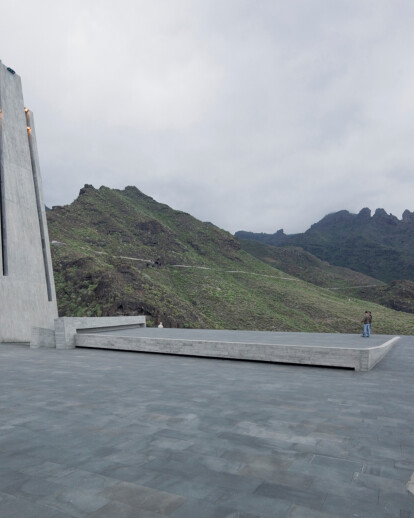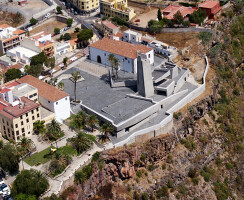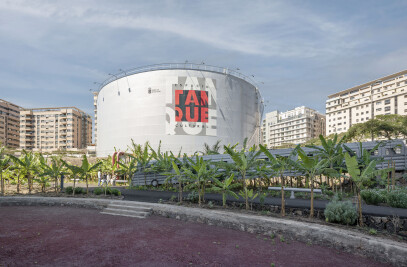In this project, architecture contributes to bringing people to the natural environment. The Museum features a large plaza that characterizes the building. The development of this area was vital to connecting the building to the environment. It arose from the idea to strengthen the relationship between the town and the natural landscape that exists around the museum. The plaza gives a public space to the town, it is a place where people can eat and enjoy the landscape which is particularly striking for the site lies next to a dry river bed known in as the “Barranco del Infierno”. Deep cuts are carved into the ground from the deluges of rain that occur between dry seasons, the barranco remains dry for a majority of the year- a place of dramatic earth formations and rocks shaped by the yearly waters.
The concept of the plaza was to act as a nuclei of public and cultural life: a place like a great gazebo within a spectacular landscape that rises above the ravines. It is a plaza that can be used as meeting point and for civic activity. It is a place to rest or play. It is its dynamic character and flexibility that creates the environment for the museum.
The top of the building frames the plaza, where the cafe is located. This volume is made of white concrete which overlooks the plaza like a church overlooking a city. The building uses light colors and contained geometry. The location and design frame the existing layout, while respecting its historic configuration.
The Sacred Museum exists as telluric architecture, its volume hidden within the depths of the earth. Cracks within its volume create lighting that penetrates into its depths. The galleries act as a journey moving though the earth and feeling its coolness. It exists like a cave, a sacred place of quiet reflection, closed to the outside world. It is designed to evoke a spiritual resonance with the visitors, transforming a museum into a physical and emotional journey. It is a space to find oneself, or lose oneself in reflection.
The main objective is recover the concept of the plaza was to act as a nuclei of public and cultural life: a place like a great gazebo within a spectacular landscape that rises above the ravines. It is a plaza that can be used as meeting point and for civic activity. It is a place to rest or play. It is its dynamic character and flexibility that creates the environment for the museum
The volumes enclose Plaza de España to create an intimate square, at the same time offering visuals of the gully. The project is based on an open-plan ground floor and lays out the rest of the programme on platforms that are terraced to offer the best vistas.
The highest level houses the historical archive and library. Its forms respond to a more contained geometry that belongs to the exterior world and the existing fabric of the town. This element has the twofold role of framing the square, by respecting its historical configuration, but also freeing the ground floor to open up to the landscape that extends beyond the gully.
The entire surface of the square is freed up and has a clear visual and functional relation with the gully. It combines the function of the square as a place of sociability, a place to see and be seen, like the Greek agora, and as an open-air theatre with the landscape as a backdrop. In this way, the town of Adeje overlooks the gully: its own sea—a sea on which it has traditionally turned its back.
The exhibition spaces (ethnological museum, museum of photography and museum of sacred art) belong to a telluric world in which overhead light drawn in through a winding itinerary gives free rein to the sensations. Itineraries reminiscent of the cave, perhaps evoking the Resurrection. A blend between a sacred place and a museum, both, curiously, places to find—or to even lose—oneself.
According to the citizens of Adeje, the new square perfectly fulfills the objectives determined by the municipality. It was outstanding that the proposal had to put the historical setting of the town in importance, constituted by two very emblematic and historical buildings: the franciscan Convent and the Church Santa Úrsula, who frame the square at both sides.
But above all, the reformation of the square supposes a very important dynamical approach of the historic centre of Adeje. Its multifunctional capacity has allowed to celebrate many different outdoor events, with the magnificent landscape of the cliff in the scene's background, donating an equipment to the municipality that was lacking before.
The citizens have "occupied" the new square in different ways: concerts, sport events, religious events, markets, manifestations, etc. considering that the new square as a space of the municipality, should have already been there.

































